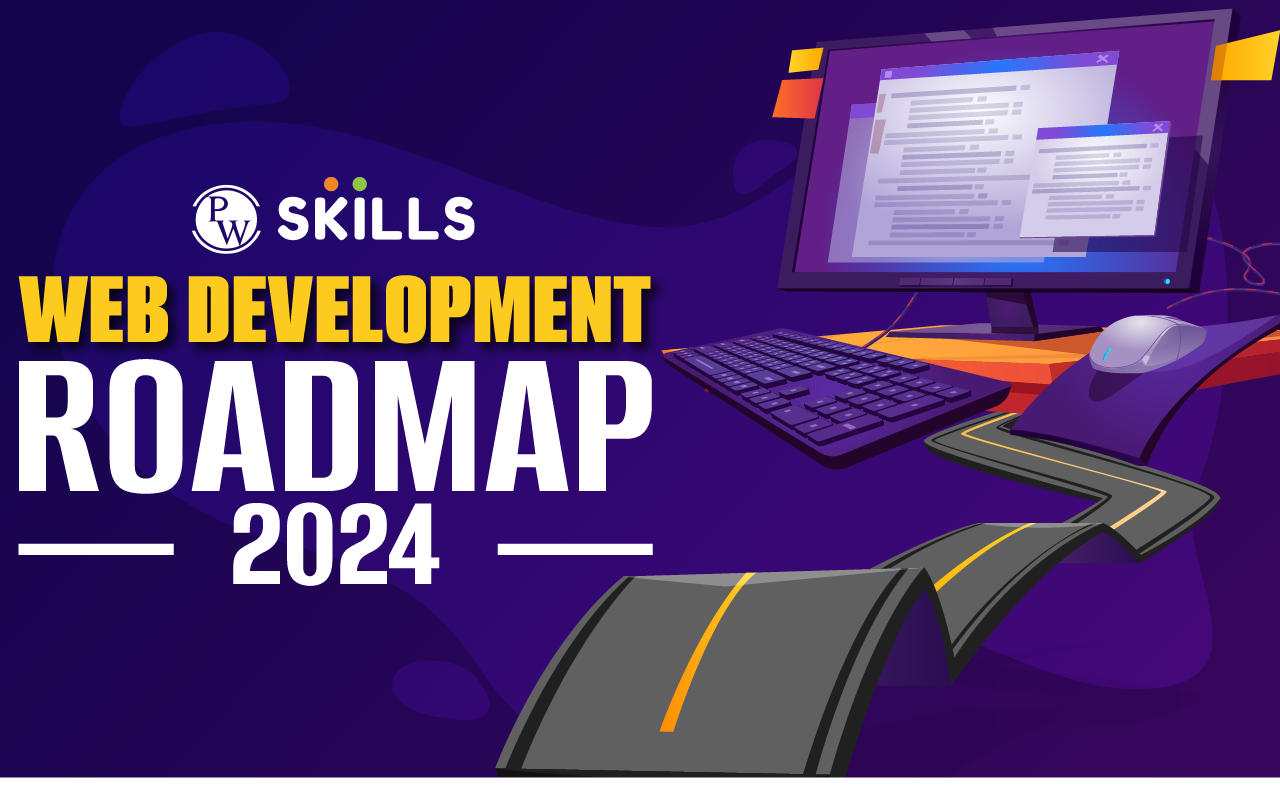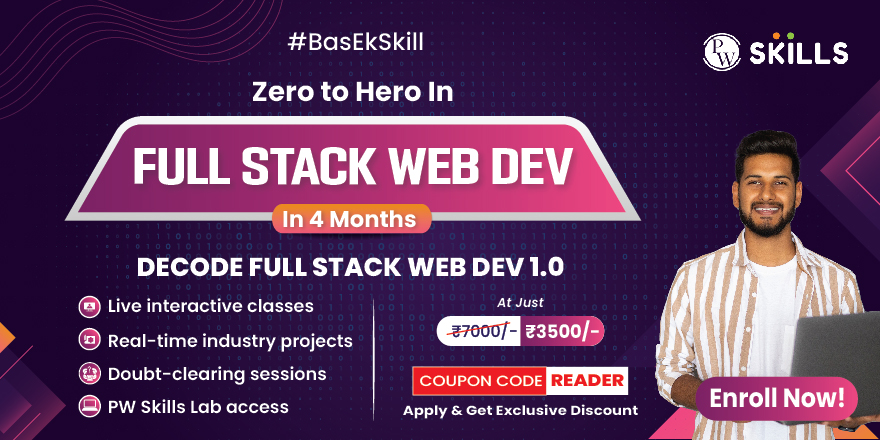A Web Development Roadmap 2024 can be really helpful for someone starting out as a beginner in the web development world. So, we have provided the complete Web Development Roadmap 2024 in this blog!
Web Development Roadmap 2024: Web development stands out as a thriving, well-paying, and genuinely promising profession in the IT industry, attracting the interest of many tech enthusiasts. Do you also wish to venture into the realm of web development? Are you a total beginner? If so, you’ve landed in the right spot to kickstart your journey as a web developer.
Curious about where to discover the entire guide for web development as a beginner? Don’t worry; this blog is entirely dedicated to providing a comprehensive Web Development Roadmap 2024 for beginners, guiding you from the basics to advanced topics.
If you’re looking to become a high-paid web developer, then PhysicsWallah’s Full Stack-Web Development course is just what you need! In our course, you’ll be taught by industry leaders that will teach you everything you need to know for success. So, don’t wait! Use the coupon code – “READER” and get an exclusive discount on all courses from PW Skills!
What is Web Development?
We depend on web applications for our daily tasks. Currently, around 200 million active websites are in use. So, choosing a career in web development is a good option. It allows you to contribute to improving the world and also offers a good salary. Web development involves creating and managing websites using various technologies. It is divided into three main parts:
- Front-end: This is what users can see and interact with, focusing on their experience.
- Back-end: This part is not accessible to users and serves as the website’s backbone.
- Database: It stores and manages data used by the website.
How do Websites Work?
Every website, in its most basic form, consists of files stored on a computer known as a server. This server is connected to the internet. To view the website, you use a browser such as Chrome, Firefox, or Safari on your computer or phone. In this situation, your browser is also referred to as the client.
When you’re on the internet, you (the client) receive and load data, such as cat pictures, from the server. Additionally, you can send data back to the server, like requesting more cat pictures. This exchange between the client and the server forms the foundation of the internet.
Everything accessible in your browser is created by a web developer. Examples range from simple small business websites and blogs to more complex web applications like Airbnb, Facebook, and Twitter.
Recommended Technical Course
- Full Stack Web Development Course
- Generative AI Course
- DSA C++ Course
- Java+DSA 1.0 Course
- Data Analytics Course
- Data Science with ML 1.0 Course
Salary of a Web Developer
Web developers are among the highest-paid professionals in India and abroad. They can work either as full-time employees or as freelancers for specific periods. The salary of a web developer depends on their skills and experience. Let’s explore the average salaries of web developers in different locations:
- In India, the average salary is around 7 LPA.
- In the USA, the average salary is approximately $76k.
Web developers are currently in high demand, and this trend is expected to continue in the future. The global count of developers is steadily increasing and is currently more than 26.8 million.
Also read: 12 Best Full Stack Web Development Courses in India
Overview of a Typical Web Development Roadmap
Web development involves a lot of work, especially since web-based solutions help manage systems and processes across various industries through the internet. This openness can be both appealing and overwhelming.
To better understand the role, here’s a common journey a web developer might take in their career:
- Education: While having a degree in Computer Science or a similar technical field is good, it’s not necessary. Many web developers start with online courses, tutorials, and self-guided learning.
- Building a Portfolio: Making a personal portfolio by working on small projects or contributing to open-source initiatives shows skills and can make a candidate more appealing to employers.
- Entry-Level Position: Beginning as a junior web developer, a new professional will likely work under the guidance of a more experienced developer, learning best practices and starting to contribute to real-world projects.
- Specialisation: As skills develop, a developer may focus on a specific area, like Front-End Development, Back-End Development, or Full-Stack Development.
- Mid-Level Development: With experience, a web developer may move into a mid-level position, taking on more responsibilities, leading smaller projects, and guiding junior team members.
- Networking and Community Involvement: Getting involved with local or online developer communities, attending conferences, and contributing to industry discussions can lead to personal growth and new opportunities.
- Senior-Level and Leadership Roles: As a senior developer, leadership in technical decision-making, architecture design, and team management become important parts of the role.
- Continuous Learning and Adaptation: Web development is always changing. Successful developers often set aside time to learn new technologies, methodologies, and best practices to stay current and competitive.
- Potential Career Transitions: Some web developers may eventually move into related fields like project management, product management, UX/UI design, or even start their own development agency or tech start-up.
- Optional Certifications: While not required, getting certifications in specific technologies or methodologies can boost credibility and demonstrate expertise in a specialised area.
There’s no fixed time required to learn web development, but different job roles will have different criteria for the level of experience needed.
Also read: Future of Web Development 2023 and Beyond
Web Development Roadmap 2024 for Beginners
Let’s begin the full-stack developer roadmap, but before that, you’ve to be more focused and curious to learn the fundamentals clearly and in-depth.
1) Website and Web Servers
The basic thing that you must know before starting to learn about web development is about websites and web servers. These are the basic fundamentals on which the entire system works, hence, you must have a full-fledged knowledge of them. Both websites and web servers play a significant role in web development as the whole of the web application relies on them.
A website is a collection of web pages that are identified by a common domain name and published on a server. A simple web page is a page that users can view and is built using languages like HTML and CSS. A server is a system that stores files and software. The server connects the system to the internet and eases the data interchange with other devices.
2) HTML, CSS, and JavaScript
HTML, or HyperText Markup Language, is the fundamental building block for creating a web page. Starting your journey in web development can begin with HTML. It’s essential to grasp the basics of how HTML functions, learning about its elements and practising by constructing some interesting web pages.
Learning any language requires daily practice. Work on various projects, progressing from basics to more advanced levels. You can use Integrated Development Environments (IDEs) or even Notepad to edit and save your code with the .html extension. Just execute the file to witness those wonderful codes transforming into a web page.
CSS, which stands for Cascading Style Sheets, accompanies HTML to enhance the appearance of a web page, making it visually appealing. Acquiring a solid understanding of CSS is crucial for making your webpage attractive to users. Expand your knowledge of CSS by gradually incorporating more elements into your projects. Engage in HTML and CSS projects to craft visually stunning web pages.
JavaScript holds the status of being the most sought-after programming language, currently favoured by over 74% of the developer community. Once you’ve developed a profound understanding of HTML and CSS, JavaScript becomes the next programming language to create dynamic, interactive, and user-friendly web applications.
Initiate your journey by implementing small projects, like a calculator or to-do list, using HTML, CSS, and JavaScript. As you deepen your comprehension of JavaScript, progress to more advanced projects.
3) Frontend Development
The next ability you should acquire is front-end development. Front-end development involves creating the user interface that people see and use. It’s the part of the website or app that users interact with directly. Once you grasp the basics of programming languages like HTML, CSS, and JavaScript, it’s important to learn how to make the front page of the website or app look good and work smoothly.
4) Responsiveness
Responsiveness is a design method that allows the web application to adjust automatically to different screen sizes. Ensure your website is constructed to fit well on all screens, including desktops, mobiles, and tablets. It’s important that users can easily view your web application on any device. If your web application is only designed for desktops and not for mobiles, it won’t be useful. Building a responsive web application is crucial, so make sure to prioritise this aspect during development.
5) Backend Development
Understanding back-end development is crucial, as it forms the core of web development. It serves as the foundation for the entire web application, facilitating communication between the front end and the database.
To grasp back-end development, start with the basics. Begin by creating a back-end for a small project, and then gradually enhance it with updates to tackle larger projects. Through consistent practice, you’ll gain insight into its workings, enabling you to handle more complex enterprise applications later on.
6) Frameworks
You can proceed by learning about frameworks. A framework is a set of tools used in web development to assist developers in creating web applications rapidly and with ease. Various frameworks are employed for both front-end and back-end development. Frameworks simply aid in creating software more effectively.
Some of the most preferred front-end frameworks are:
- React
- Angular
- Vue
Some of the most preferred back-end frameworks are:
- Node
- ExpressJS
Note: Every programming language has its own framework like
- Django for Python
- Spring for Java
- Laravel for PHP
- many others
7) Database Management System
To grasp how to handle data effectively, it’s essential to be familiar with the database management system (DBMS) for software developers. DBMS is crucial in web development. When creating a web app, it’s important to comprehend how data flows and learn how to manage it, especially when dealing with large datasets.
Gain knowledge about DBMS and incorporate it into your work on web apps. Go through documents on databases, grasp the fundamental concepts and how they function. Endeavour to apply the database in the web app you are developing.
8) Version Control System
A Version Control System (VCS) is a tool that monitors changes in your code when creating a web app. Git is a well-known VCS that keeps track of and documents these modifications. Developers use VCS to make alterations to the code without impacting the original version.
It upgrades the software by adding new features, creating a newer version, and allows you to revert changes to return to the previous version. By using undo and redo commands to manipulate versions, it earns the name “version control system.”
9X) Deployments
Deployment means putting or moving your web app into a deployed state. It’s the way of making your software or web apps available to a lot of users. Deployment is an important step to understand if you want to share your website on the internet for local users. It’s like giving life to your web application.
10) Work on Projects and Resume
Once you’ve learned all the important skills needed to be a web developer, it’s time to test yourself by creating real-life projects. Start with simple ones and then move on to more advanced projects. By working on these projects, you are on your way to becoming a successful web developer.
Now that you are a web developer, update your resume with the skills you’ve acquired and the projects you’ve completed. Make a resume that is compatible with ATS, which is highly sought after in the current IT industry. A well-crafted resume increases your chances of passing technical interviews and securing positions in multinational companies.
Also read: How to Become a Full Stack Developer Step-by-Step Guide
Front-End vs. Back-End vs. Full-Stack Development
Your online application exists in a suitable hosting place. It gets sent to a user’s space through TCP/IP in these steps:
- The user or the “Front-End” sends an HTTP request to the hosting domain/IP with a request URL and some extra information in the form of HTTP headers.
- The server or “Back-End” gets the request and decides what kind of response and extra information to send back to the user.
- The user gets a response and shows it as a web page in the browser tab.
So, when a single webpage loads, the user starts the process, the server checks the request and figures out how to fulfil it, and in the end, the user gets a response to finish the data exchange.
This separation of systems into Front-End and Back-End is the foundation for understanding the Internet’s progress, delivery, performance, and security aspects. This applies in both technical and conceptual terms.
The three types of web development are derived from this:
- Back-End Development: Creating the main system that can get requests, get into databases, do calculations, and manage many clients at once. It can be a fixed, moving, or mixed system.
- Front-End Development: This means coding the replies clients get, usually as HTML pages with lots of things like UI parts, hyperlinks, and such. It centres on making a version of the website/app that can be used on the client side.
- Full-Stack Development: This is about handling both front-end and back-end development together. A Full-Stack Developer can work on both the user side and server side of the app, dealing with all the data movement between the user and the server.
Each web development area has its own traits, benefits, and problems. Deciding on Front-End, Back-End, or Full-Stack development depends on your project needs, job goals, or team setup.
- If you’re more into making things look good and user interaction, Front-End development might be your thing.
- If you like solving logical problems, dealing with data, web servers, and server-side tasks, Back-End development might be a good choice.
- Full-Stack development is there if you want to handle both sides and see the whole web development process.
FAQs
How does TDD (Test-Driven Development) benefit developers?
TDD encourages writing tests before code, ensuring that each component functions as intended and making it easier to identify and fix issues.
Which cloud platforms are commonly used in web development?
AWS, Azure, and Google Cloud are popular cloud platforms that offer a range of services for hosting, storage, and scalability.
Why is database indexing important for backend performance?
Database indexing enhances query performance by creating efficient data structures, speeding up data retrieval processes.
How can developers stay updated with industry trends?
Actively participating in the developer community, attending conferences, and following reputable blogs and forums help stay informed about the latest trends.
What are the advantages of using CSS preprocessors like SASS or LESS?
CSS preprocessors provide features like variables, mixing, and nesting, making CSS code more maintainable and scalable.





